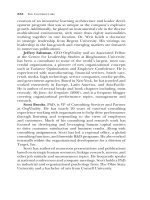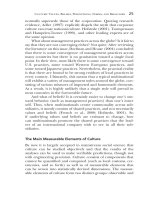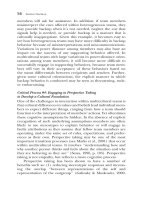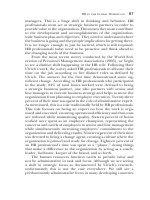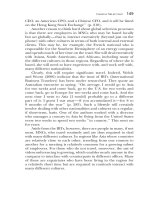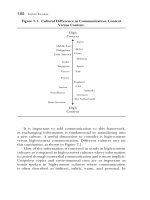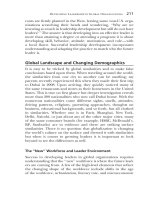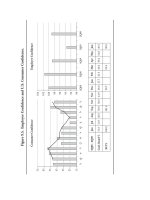International marketing 8th edition czinkota and ilkka
Bạn đang xem bản rút gọn của tài liệu. Xem và tải ngay bản đầy đủ của tài liệu tại đây (14.39 MB, 714 trang )
international
marketing
8e
Michael R. Czinkota
Georgetown University
Ilkka A. Ronkainen
Georgetown University
International Marketing, 8th Edition
Michael R. Czinkota and Ilkka A. Ronkainen
VP/Editorial Director:
Jack W. Calhoun
Manager of Technology, Editorial:
Vicky True
Art Director:
Stacy Jenkins Shirley
VP/Editor-in-Chief:
Dave Shaut
Technology Project Editor:
Pam Wallace
Internal and Cover Designer:
c miller design
Publisher:
Neil Marquardt
Manufacturing Coordinator:
Diane Lohman
Cover Images:
© Getty Images
Sr. Developmental Editor:
Emma F. Guttler
Production House:
Interactive Composition Corporation
Photography Manager:
John Hill
Marketing Manager:
Nicole C. Moore
Printer:
Edwards Brothers
Ann Arbor, MI
Photo Researcher:
Rose Alcorn
ALL RIGHTS RESERVED.
No part of this work covered by the
copyright hereon may be reproduced
or used in any form or by any
means—graphic, electronic, or
mechanical, including photocopying,
recording, taping,Web distribution
or information storage and retrieval
systems, or in any other manner—
without the written permission of
the publisher.
Library of Congress Cataloging-inPublication Data
Content Project Manager:
Starratt E. Alexander
COPYRIGHT © 2007
Thomson South-Western, a part of
The Thomson Corporation.Thomson,
the Star logo, and South-Western are
trademarks used herein under license.
Printed in the United States of
America
1 2 3 4 5 10 09 08 07 06
ISBN 0-324-31702-6
For permission to use material from
this text or product, submit a request
online at
.
Czinkota, Michael R.
International marketing / Michael R.
Czinkota, Ilkka A. Ronkainen. — 8th ed.
p. cm.
1. Export marketing. I. Ronkainen,
Ilkka A. II.Title.
HF1416.C953 2007
658.8'4—dc22
2006020788
For more information about our
products, contact us at:
Thomson Learning Academic
Resource Center
1-800-423-0563
Thomson Higher Education
5191 Natorp Boulevard
Mason, OH 45040
USA
To Ilona and Margaret Victoria—MRC
To Susan, Sanna, and Alex—IAR
Preface
hank you for reading our book! Practicing international marketing and writing
a text on the subject have much in common. The focus is on delighting the
customer; it is a lot of work; the competition is tough; and it’s fun to succeed.
It is therefore with great pleasure that we present the eighth edition of International Marketing to you. We have made significant revisions in this edition, but our
goals continue to be excellence and relevance in content, combined with userfriendliness for both the student and the professor. We have greatly streamlined the text,
which now comprises 18 chapters. We have done so to balance the workload for the
reader but without taking shortcuts. We have combined topics, eliminated redundancies,
and tightened content wherever possible. The result is a shorter, crisper text of better
quality.
We now address in depth controversies surrounding issues such as globalization, terrorism, and international aid. We paint a broader picture of the implications of a market
orientation, and highlight ethical concerns. We discuss the shortcomings encountered in
corporate transparency and executive veracity. We also provide much deeper data analysis and support. For example, in addition to discussing the leading economic regions, we
offer comparative benchmarks from China, Australia, Kenya, and Brazil. Overall, we unabasheduly admit that this eight edition of International Marketing is the best one yet!
Here are the key features that make this book stand out:
T
• We cover the full spectrum of international marketing, from start-up operations to the
formation of virtual alliances.We offer a thorough discussion of the operations of multinational
corporations, but also present a specific focus on the activities of small and medium-sized firms,
which are increasingly major players in the international market and will be the employers of
many students.
• We provide a hands-on analysis of the growing interaction between government and business.
We have served in government positions and advised international organizations. We know
what role governmental considerations can play for the international marketer. This policy
orientation greatly enhances the managerial relevance of this book.
• We cover both the theory and the application of international marketing. Based on our
personal research record and business experience, we can offer research insights from around
the globe and show how corporations are adjusting to the marketplace realities of today.
• We acknowledge and give clear examples of how the world has changed in an era of terrorism,
hostility, and distrust. We look at the marketing repercussions of these changes on people
management, sourcing policies, cargo security, inventory management, and port utilization.
However, we also draw on our work with corporations to find new forms of collaboration and
network building without compromising safety or security.
• We address the concerns of emerging and developing markets throughout the text. We
present the issue of underserved markets, with a population of four billion, and also suggest
how these people and countries can become greater participants in marketing efforts.
• We examine international marketing from a truly global perspective. By addressing, confronting,
and analyzing the existence of different environments, expectations, and market conditions, we
highlight the need for awareness, sensitivity, and adaptation.
• We integrate the e-commerce and Web impact on the international marketer. We discuss
the revolutionary changes in communication between firms and their customers and
suppliers, and present the latest consequences for international market research and market
entry.
iv
Preface
Personal Support
Most important, we personally stand behind our product and we will work hard to delight
you. Should you have any questions or comments on this book, you can contact us, talk
to us, and receive feedback from us.
Michael R. Czinkota
(202) 687-4204
Ilkka A. Ronkainen
(202) 687-3788
Organization
The text is designed primarily for the advanced undergraduate student with prior exposure to the marketing field. Because of its in-depth coverage, it also presents an excellent
challenge for graduate instruction and executive education.
The text is divided into four parts. First, the core concepts of international marketing
are outlined, and the environmental forces that the international marketer has to consider
are discussed. The second part focuses on international market entry and development.
We cover strategic planning for internationalization, organizing for implementation,
preparing through research, and executing the entry. Part Three addresses the elements
of the marketing mix that are most important for firms at an initial level of the international experience. Part Four discusses the marketing management issues most relevant to
the expanded global operations of multinational corporations. We conclude with an appendix of international employment opportunities.
Both the instructor and the student can work with this text in two ways. One alternative is to cover the material sequentially, progressing from the initial international effort to
multinational activities. In this way, marketing dimensions such as distribution, promotion, and pricing are covered in the order in which they are most relevant for the particular level of expertise within the firm. Another approach is to use the text in a parallel
manner, by pairing comparable chapters from Parts Two, Three, and Four. In this way, the
primary emphasis can be placed on the functional approach to international marketing.
Key Features
The eighth edition reflects the highly dynamic nature of the international marketplace. We
offer a perspective on the shift from marketplace to market space, and the impact of this
revolution on international marketers in terms of outreach, research, and competition.
Our International Marketplace vignettes reflect state-of-the-art corporate practices. We
have included links to the Web sites of companies, data sources, governments, international organizations, and monitors of international marketing issues.
Our focus on the physical environment and geography is strong. Updated maps provide context in terms of social and economic data. An appendix directly addresses the
relationship between geography and international marketing. New text components, marketplaces, and several cases specifically focus on the environment and the opportunities,
challenges, and ambiguities that it poses to international marketers.
This edition gives increased attention to developing economies and economies in transition. In Part One, international organizations such as the World Bank, the World Trade
Organization, the International Monetary Fund, and the United Nations are covered, along
with the public debate surrounding these institutions. In particular, we focus on the evolving role of the World Trade Organization and the push for the conclusion of the Doha
Round. A case later in the book highlights the controversies surrounding the United
Nations’ Oil for Food Program. We have increased the focus on ethics and corporate citizenship in this section and strengthened our discussion of intellectual property rights.
We broaden our discussion of emerging markets by systematically addressing the issue
of dealing with markets at the bottom of the income pyramid. Our revised strategy section
v
vi
Preface
is now linked directly with organization, implementation, and research concerns. We have
completely recast the chapter on market entry and expansion to include a wider variety
of ways in which firms go global. All of these strategies are now integrated into one chapter, organized around our model of the internationalization process.
The marketing mix discussions now include new technologies and their impact. For
example, we present the effect of consumer generated media (such as blogs) and new opportunities presented by m-payments through mobile devices. We offer specific sections
on outsourcing by involving partners in research and design, on the effect of terrorism on
international transportation, and the reconfiguration of web-based services. New also is
the focus on how local companies can defend against global players and win, and our
emphasis is on sponsorship and ambush marketing. The final appendix of international
employment opportunities helps students prepare for the implementation steps yet to
come.
Innovative Learning Tools
Contemporary Realism
Each chapter offers three current International Marketplace boxes. They focus on real
marketing situations and help students understand and absorb the presented materials.
The instructor can highlight the boxes to exemplify theory or use them as mini-cases for
class discussion.
Research Emphasis
A special effort has been made to provide current research information and data from
around the world. Chapter notes are augmented by lists of relevant recommended readings incorporating the latest research findings. In addition, a wide variety of sources and
organizations that provide international information are offered in the text. These materials enable the instructor and the student to go beyond the text when desired.
Internet Focus
The Internet, electronic commerce, and the World Wide Web affect all of international
marketing. We highlight how the way of reaching customers and suppliers has changed
given the new technology. We explain the enhanced ability of firms to position themselves internationally in competition with other larger players. We offer insights into the
electronic marketing research process and present details of how companies cope with
new market realities. Whenever appropriate, we direct readers to Internet resources that
can be useful in updating information. Each chapter also provides several Internet questions in order to offer training opportunities that make use of the Internet.
Geography
This edition contains several maps, covering the social, economic, and political features
of the world. In addition, several chapters have maps particularly designed for this book,
which integrate the materials discussed in the text and reflect a truly “global” perspective.
These maps enable the instructor to visually demonstrate concepts such as socioeconomic
variables or exposure to terrorism. An appendix, dealing specifically with the impact of
geography on international marketing, is part of Chapter 1.
Cases
Following each part of the text are a variety of cases, three quarters of which are either
new or updated especially for this edition, that present students with real business situations. All cases address the activities of actual or former companies and cover a broad
geographic spectrum. In addition, a number of video cases further help to enliven
classroom activity. Challenging questions accompany each case, permitting in-depth discussion of the materials covered in the chapters.
Preface
Ancillary Package
Instructor’s Resource CD-ROM
(IRCD; ISBN: 0-324-36108-4)
Key instructor ancillaries (Instructor’s Manual, Test Bank, ExamView, and PowerPoint
slides) are provided on CD-ROM, giving instructors the ultimate tool for customizing lectures and presentations.
Instructor’s Manual
Available on the IRCD and the password-protected instructor’s resource Web site, the text
is accompanied by an in-depth Instructor’s Manual, devised to provide major assistance
to the professor. The material in the manual includes the following:
• Teaching Plans Alternative teaching plans and syllabi are presented to accommodate the
instructor’s preferred course structure and varying time constraints.Time plans are developed
for the course to be taught in a semester format, on a quarter basis, or as an executive
seminar.
• Discussion Guidelines For each chapter, specific teaching objectives and guidelines are
developed to help stimulate classroom discussion.
• End-of-Chapter Questions Each question is fully developed in the manual to accommodate different scenarios and experience horizons. In addition, each chapter has Internetbased exercises in order to offer students the opportunity to explore the application of new
technology to international marketing on their own.
• Cases A detailed case-chapter matrix is supplied that delineates which cases are most
appropriate for each area of the international marketing field. In addition, detailed case
discussion alternatives are provided, outlining discussion strategies and solution alternatives.
• Video and Film References An extensive listing of video and film materials available
from educational institutions, companies, and government agencies is provided. Materials are
briefly discussed, possible usage patterns are outlined, and ordering/availability information is
supplied.
Test Bank
Available on the IRCD and the password-protected instructor’s resource Web site, the revised and updated Test Bank includes a variety of multiple choice, true/false questions,
and cases, which emphasize the important concepts presented in each chapter. The Test
Bank questions vary in levels of difficulty so that instructors can tailor their testing to meet
their specific needs.
ExamView (Computerized) Test Bank
Available on the IRCD, ExamView contains all of the questions in the printed Test Bank.
This program consists of easy-to-use test creation software compatible with Microsoft
Windows. Instructors can add or edit questions, instructions, and answers, and select
questions (randomly or numerically) by previewing them on the screen. Instructors can
also create and administer quizzes online, whether over the Internet, a local area network
(LAN), or a wide area network (WAN).
PowerPoint Presentation Slides
Available on the IRCD and the Web site, the PowerPoint Lecture Presentation enables
instructors to customize their own multimedia classroom presentations. The package includes select figures and tables from the text, as well as outside materials to supplement
chapter concepts. Material is organized by chapter, and can be modified or expanded for
individual classroom use. PowerPoint presentations are also easily printed to create customized Transparency Masters.
vii
viii
Preface
Web Site www.thomsonedu.com/marketing/czinkota
Visit the text Web site to find instructor’s support materials, as well as study resources that
will help students practice and apply the concepts they have learned in class.
Student Resources
• Crossword puzzles that use glossary terms and definitions arranged by chapter, for extra
review of key terms found in the text.
• Interactive Quizzes
• Internet Exercises
• Links to news articles and hot marketing topics are provided for extra student research.
Instructor Resources
• Downloadable Instructor’s Manual files
• Downloadable PowerPoint presentation files
• Downloadable Test Bank files
DVD Videos (ISBN: 0-324-36110-6)
A video package has been prepared to correspond with the key concepts taught in the
text. These videos, featuring companies such as Pier One Imports and Whirlpool, coincide
with the video cases found at the end of each part in the text. Professors can assign the
cases after presenting videos in class or use these cases to simply illustrate a key point.
Acknowledgments
e are deeply grateful to all the professors, students, and professionals using
this book. Your interest demonstrates the need for more knowledge about
international marketing. As our market, you are telling us that our product
adds value to your lives. As a result, you add value to ours. Thank you!
We also thank the many reviewers for their constructive and imaginative comments and
criticisms, which were instrumental in making this edition even better.
For their contributions to this revision, we would like to thank the following:
W
Subir Bandyopadhyay
Indiana University
Northwest
Katharine A. Bohley
Hubbard
University of
Indianapolis
Carl E. Dresden
Coastal Carolina University
Ann L. Langlois
Palm Beach Atlantic
University
Zahir A. Quraeshi
Western Michigan
University
F. J. Sarknas
Duquesne University
Tomasz Mroczkowski
American University
Regina P. Schlee
Seattle Pacific University
Samit Chakravorti
Florida International
University
Amit Mukherjee
Auburn University
Odile J. Streed
Concordia College
Farok J. Contractor
Rutgers University
Cheryl Nakata
University of Illinois—
Chicago
We remain indebted to the reviewers and survey respondents of this and earlier editions
of this text:
Sanjeev Agarwal
Iowa State University
John Dyer
University of Miami
Zafar Ahmed
Texas A&M—Commerce
Luiz Felipe
IBMEC Business
School (Rio de Janeiro,
Brazil)
Lyn S. Amine
St. Louis University
Jessica M. Bailey
The American University
Warren Bilkey
University of Wisconsin
S. Tamer Cavusgil
Michigan State University
Shih-Fen Chen
Kansas State University
Alex Christofides
Ohio State University
Dr. John P. Fraderich
Southern Illinois
University—Carbondale
Roberto Friedmann
University of Georgia
Shenzhao Fu
University of San
Francisco
Jim Gentry
University of Nebraska
Robert Dahlstrom
University of Kentucky
Donna Goehle
Michigan State
University
Paul Dowling
University of Utah
Needlima Gogumala
Kansas State University
Peter J. Gordon
Southeast Missouri State
University
Paul Groke
Northern Illinois
University
Andrew Gross
Cleveland State University
John Hadjimarcou
University of Texas
at El Paso
Hari Hariharan
DePaul University
Braxton Hinchey
University of Lowell
Carol Howard
Oklahoma City University
G. Thomas M. Hult
Florida State University
Basil Janavaras
Mankato State University
ix
x
Acknowledgments
Denise Johnson
University of Louisville
Sudhir Kale
Arizona State University
Ceyhan Kilic
DePaul University
Hertha Krotkoff
Towson State University
Kathleen La Francis
Central Michigan
University
Trina Larsen
Drexel University
Edmond Lausier
University of Southern
California
Bertil Liander
University of
Massachusetts
Mushtaq Luqmani
Western Michigan
University
Isabel Maignan
Florida State University
James Maskulka
Lehigh University
James McCullouch
Washington State
University
Matthew Sim
Temesek Business School
(Singapore)
Fred Miller
Murray State University
James Spiers
Arizona State University
Joseph Miller
Indiana University
Janda Swinder
Kansas State University
Mark Mitchell
University of South
Carolina—Spartanburg
Ray Taylor
Villanova University
Henry Munn
California State
University, Northridge
Jacob Naor
University of Maine,
Orono
Urban Ozanne
Florida State University
Tony Peloso
Queensland
University of Technology
(Australia)
Ilsa Penaloza
University of Connecticut
John Ryans
Kent State University
Tyzoon T. Tyebjee
Santa Clara University
Robert Underwood
Virginia Polytechnic Institute and State University
Robert Weigand
University of Illinois
at Chicago
John Wilkinson
University of South
Australia
Sumas Wongsunopparat
University of Wisconsin—
Milwaukee
Nittaya Wongtada
Thunderbird
Van R. Wood
Texas Tech University
Many thanks to all the colleagues and students who have helped us sharpen our thinking by cheerfully providing challenging comments and questions. In particular, we thank
Bernard LaLonde, The Ohio State University; Lyn Amine, St. Louis University; Tamer
Cavusgil, Michigan State University; and James Wills, University of Hawaii.
Many colleagues, friends, and business associates graciously gave their time and knowledge to clarify concepts; provide us with ideas, comments, and suggestions; and deepen
our understanding of issuses. Without the direct links to business and policy that you have
provided, this book could not offer its refreshing realism. In particular, we are grateful to
Secretaries Malcolm Baldrige, C. William Verity, Clayton Yeutter, and William Brock for the
opportunity to gain international business policy experience and to William Morris, Paul
Freedenberg, and J. Michael Farrell for enabling its implementation. We also thank William
Casselman of Stairs Dillenbeck Kelly Merle and Finley, Robert Conkling of VSSL Corporation, Lew Cramer of CAPPA Inc., Mark Dowd of IBM, David Danjczek of the Global Offset
and Countertrade Association, and Veikko Jaaskelainen and Reijo Luostarinen of HSE.
We also thank the colleagues who have generously written new cases to contribute to
this new edition of our book. They are Professor Svetla Marinova of the University of
Birmingham, Professor Lluis Renart of IESE, Hannu Serisitö of HSE, and Professor Thomas
Cooke of Georgetown University.
Valuable research assistance was provided by our student research elite team. They
made important and substantive contributions to this book. They pursued research information with tenacity and relentlessness; they organized and analyzed research materials,
prepared drafts of vignettes and cases, and reinforced everyone on the third floor of Old
North with their can-do spirit. They are Darra Cherepennikova, Anastasiya Grouverman,
Acknowledgments
Natalya Skiba, Elizaveta Berg, Daina Xie, and Dennis Wang, all of Georgetown University.
We would also like to thank Samantha Vinograd for her tireless work on reviewing the
manuscript. We appreciate all of your work.
A very special word of thanks to the people at Thomson Business and Economics.
Melissa Acuña and Neil Marquardt have the vision but haven’t lost their hands-on approach. Nicole Moore continues to expertly market the text. Emma Guttler supported the
lengthy process of writing a text with her input and feedback. Emily Gross and Starratt
Alexander helped us in the final stretch of production. Stacy Shirley created the outstanding design and John Hill provided art research and permission coordination.
Foremost, we are grateful to our families, who have truly participated in our labors.
Only the patience, understanding, and love of Ilona and Margaret Victoria Czinkota and
Susan, Sanna, and Alex Ronkainen enabled us to have the energy, stamina, and inspiration to write this book.
Michael R. Czinkota
Ilkka A. Ronkainen
Washington, DC
August 2006
xi
About the Authors
Michael R. Czinkota teaches international marketing and business at the Graduate School
and the Robert Emmett McDonough School of Business at Georgetown University. He has
held professorial appointments at universities in Asia, Australia, Europe, and the Americas.
Dr. Czinkota served in the U.S. government as Deputy Assistant Secretary of Commerce.
He also served as head of the U.S. Delegation to the OECD Industry Committee in Paris and
as senior advisor for Export Controls.
Dr. Czinkota’s background includes eight years of private-sector business experience as
a partner in a fur trading firm and in an advertising agency. His research has been supported by the U.S. government, the National Science Foundation, the Organization of
American States, and the the American Management Association. He was listed as one of
the three most published contributors to international business research in the Journal of
International Business Studies, and has written several books, including Best Practices in
International Marketing and Mastering Global Markets (Thomson).
Dr. Czinkota served on the Global Advisory Board of the American Marketing Association, the Global Council of the American Management Association, and the Board of Governors of the Academy of Marketing Science. He is on the editorial boards of Journal of the
Academy of Marketing Science, Journal of International Marketing, and Asian Journal of
Marketing. For his work in international business and trade policy, he was named a Distinguished Fellow of the Academy of Marketing Science, a Fellow of the Chartered Institute of
Marketing, and a Fellow of the Royal Society of Arts in the United Kingdom. He has been
awarded honorary degrees from the Universidad Pontificia Madre y Maestra in the Dominican Republic and the Universidad del Pacifico in Lima, Peru.
Dr. Czinkota serves on several corporate boards and has worked with corporations
such as AT&T, IBM, GE, Nestlé, and US WEST. He advises the Executive Office of the
President of the United States, the United Nations, and the World Trade Organization.
Dr. Czinkota is often asked to testify before the United States Congress.
Dr. Czinkota was born and raised in Germany and educated in Austria, Scotland, Spain,
and the United States. He studied law and business administration at the University of
Erlangen-Nürnberg and was awarded a two-year Fulbright Scholarship. He holds an MBA
in international business and a Ph.D. in logistics from The Ohio State University.
xii
About the Authors
Ilkka A. Ronkainen is a member of the faculty of marketing and international business
at the School of Business at Georgetown University. From 1981 to 1986 he served as
Associate Director and from 1986 to 1987 as Chairman of the National Center for ExportImport Studies. Currently, he directs Georgetown University’s Hong Kong Program.
Dr. Ronkainen serves as docent of international marketing at the Helsinki School of
Economics. He was visiting professor at HSE during the 1997–88 and 1991–92 academic
years and continues to teach in its Executive MBA, International MBA, and International
BBA programs. He is currently the chairholder at the Saastamoinen Foundation Professorship in International Marketing.
Dr. Ronkainen holds a Ph.D. and a master’s degree from the University of South Carolina as well as an M.S. (Economics) degree from the Helsinki School of Economics.
Dr. Ronkainen has published extensively in academic journals and the trade press. He
is a coauthor of a number of international business and marketing texts, including Best
Practices in International Marketing and Mastering Global Markets (Thomson). He serves
on the review boards of the Journal of Business Research, International Marketing Review,
and Journal of Travel Research, and has reviewed for the Journal of International Marketing and the Journal of International Business Studies. He served as the North American coordinator for the European Marketing Academy, 1984–90. He was a member of the board
of the Washington International Trade Association from 1981 to 1986 and started the association’s newsletter, Trade Trends.
Dr. Ronkainen has served as a consultant to a wide range of U.S. and international
institutions. He has worked with entities such as IBM, the Rand Organization, and the
Organization of American States. He maintains close relations with a number of Finnish
companies and their internationalization and educational efforts.
xiii
Brief Contents
Preface iv
Acknowledgments ix
About the Authors xii
Part 1
The International Marketing Environment
Chapter 1
Appendix A
Appendix B
Chapter 2
Chapter 3
Chapter 4
Chapter 5
Cases 1
Video Case 1
The Global Marketing Imperative 3
Basics of Marketing 17
Geographical Perspectives on International Marketing 21
Trade Institutions and Trade Policy 29
The Cultural Environment 51
The Economic Environment 83
The Political and Legal Environment 125
The Catfish Dispute 156
Trick or Treat 160
Marketing Cigarettes and Tobacco 164
IKEA 171
Car Financing in China 176
Equal Exchange Strives for Equality through Fair Trade 183
Part 2
International Market Entry and Development
Chapter 6
Chapter 7
Chapter 8
Appendix A
Appendix B
Chapter 9
Cases 2
Video Cases 2
Strategic Planning 187
Marketing Organization, Implementation and Control 213
Research 243
Information Sources for Marketing Issues 272
The Structure of a Country Commercial Guide 278
Market Entry and Expansion 281
Damar International 306
Polar-Adidas 308
Parker Pen Company 313
Exporting Chopsticks to Japan 316
Green Mountain Coffee Roasters 318
Doc Martens Makes Strides around the World 320
Part 3
Export Marketing Mix
Chapter 10
Chapter 11
Chapter 12
Chapter 13
xiv
Product Adaptation 325
Export Pricing 353
Marketing Communication 385
Distribution Management 413
Brief Contents
Cases 3
Video Cases 3
Dr. Eris: Cosmetics from Poland 449
Imaginarium 454
Joemarin Oy 459
The Gray Ferrari 464
Global Vendor Relations at Pier 1 Imports 467
Goya Helps Latinos Maintain Mealtime Traditions 469
Part 4
The Global Marketing Mix
Chapter 14
Chapter 15
Chapter 16
Chapter 17
Chapter 18
Appendix C
Cases 4
Video Cases 4
Global Product Management and Branding 473
Global Services 501
Global Logistics and Materials Management 523
Global Pricing 549
Global Promotional Strategies 575
Careers in International Marketing 607
International Marketing and the NBA 615
Oil for Food 618
Should Dubai Take Over U.S. Ports? 622
Blood Free Diamonds 629
Novia Scotia 632
The F-18 Hornet Offset 636
Whirlpool and the Global Appliance Industry 642
ESPN’s Worldwide Reach 645
Glossary G-1
Index I-1
xv
Contents
Preface iv
Acknowledgments ix
About the Authors xii
Part 1
The International Marketing Environment
Chapter 1
The Global Marketing Imperative 3
The International Marketplace 1.1 3
What International Marketing Is 4
The Importance of World Trade 5
Global Linkages 6
The International Marketplace 1.2 7
Domestic Policy Repercussions 8
Opportunities and Challenges in International Marketing 10
The International Marketplace 1.3 11
The Goals of This Book 11
Summary 14
Key Terms 15
Questions & Discussion 15
Internet Excercises 15
Recommended Readings 15
Notes 15
Appendix A: Basics of Marketing 17
Strategic Marketing 18
Target Market Selection 18
Marketing Management 19
The Marketing Process 19
Key Terms 20
Notes 20
Appendix B: Geographical Perspectives on International
Marketing 21
Location 21
Place 22
Natural Features 22
Human Features 23
Interaction 23
Movement 25
Region 26
Key Terms 27
Chapter 2
Trade Institutions and Trade Policy 29
The International Marketplace 2.1 29
The Historical Dimension 30
Global Division 31
Transnational Institutions Affecting World Trade 32
World Trade Organization (WTO) () 32
xvi
Contents
The International Marketplace 2.2 34
International Monetary Fund (IMF) () 34
World Bank () 35
Regional Institutions 36
Trade Positions Compared 37
A Diagnosis of the U.S.Trade Position 37
The Impact of Trade and Investment 39
The Effect of Trade 39
The Effect of International Investment 40
Policy Responses to Trade Problems 41
Restrictions of Imports 41
Export Promotion Efforts 45
A Strategic Outlook for Trade and Investment Policies 46
A U.S. Perspective 46
An International Perspective 47
The International Marketplace 2.3 48
Summary 49
Key Terms 49
Questions for Discussion 49
Internet Exercises 49
Recommended Readings 50
Notes 50
Chapter 3
The Cultural Environment 51
The International Marketplace 3.1 51
Culture Defined 54
The International Marketplace 3.2 56
The Elements of Culture 57
Language 57
Nonverbal Language 59
Religion 59
Values and Attitudes 62
Manners and Customs 63
Material Elements 65
The International Marketplace 3.3 66
Aesthetics 67
Education 67
Social Institutions 68
Sources of Cultural Knowledge 69
Cultural Analysis 72
The Training Challenge 76
The International Marketplace 3.4 78
Making Culture Work for Marketing Success 78
Summary 80
Key Terms 80
Questions for Discussion 80
Internet Excercises 80
Recommended Readings 81
Notes 81
Chapter 4
The Economic Environment 83
The International Marketplace 4.1 83
Market Characteristics 88
Population 88
Infrastructure 96
xvii
xviii
Contents
The International Marketplace 4.2 99
Impact of the Economic Environment on Social Development 100
Regional Economic Integration 101
Levels of Economic Integration 101
The International Marketplace 4.3 109
Other Economic Alliances 111
Economic Integration and the International Marketer 113
Emerging Markets 116
Adjust Entry Strategy 117
Manage Affordability 118
Invest in Distribution 118
Developing Markets 119
Research 119
Creating Buying Power 119
Tailoring Local Solutions 120
Improving Access 120
Shaping Aspirations 120
The International Marketplace 4.4 121
Summary 121
Key Terms 122
Questions for Discussion 122
Internet Exercises 122
Recommended Readings 123
Notes 123
Chapter 5
The Political and Legal Environment 125
The International Marketplace 5.1 125
Home Country Political and Legal Environment 127
Embargoes and Sanctions 127
Export Controls 129
A New Environment for Export Controls 130
Import Controls 131
Regulation of International Business Behavior 132
Host Country Political and Legal Environment 133
Political Action and Risk 133
The International Marketplace 5.2 135
Legal Differences and Restraints 138
The International Marketplace 5.3 139
Influencing Politics and Laws 140
The International Environment 142
International Politics 142
International Law 143
International Terrorism and Marketing 143
Ethical Issues 147
Corporate Governance and Responsibility 147
The International Marketplace 5.4 149
Intellectual Property 149
Bribery and Corruption 150
Summary 153
Key Terms 153
Questions & Discussion 153
Internet Exercises 154
Contents
Recommended Readings 154
Notes 154
Cases 1
The Catfish Dispute 156
The U.S. Catfish Industry 156
The Issue 156
Congressional Reaction:The Labeling Dispute 157
When Is a Catfish a Catfish? 157
Department of Commerce and International Trade Commission 157
The Issue and Free Trade 158
Questions for Discussion 158
Notes 158
“Trick-or-Treat?” Costume Market in Horror as
Halloween Approaches 160
Fighting Imports 160
Turning the Tide 161
Marketing Cigarettes and Tobacco 164
The Importance of Tobacco for the U.S. Economy 164
The Importance of Tobacco Exports 164
U.S.Trade Policy 166
Tobacco Marketing in the United States and the Developing World 167
Government Support of the Tobacco Industry 168
Conflicting Objectives 168
Questions for Discussion 169
Sources 169
IKEA 171
The IKEA Concept 171
IKEA in the Competitive Environment 173
IKEA in the United States 174
Questions for Discussion 175
Car Financing in China 176
China and the WTO 176
Changes in the Chinese Car Market 179
Current Market Structure for Car Financing in China 180
Expected Market Changes in Car Financing in China 180
Options for Market Entry and Development 181
GMAC’s Competitive Position 181
Implications for Global Operations 182
Questions for Discussion 182
Video
Case 1
Equal Exchange Strives for Equality through Fair Trade 183
Questions for Discussion 184
xix
xx
Contents
Part 2
International Market Entry and Development
Chapter 6
Strategic Planning 187
The International Marketplace 6.1 187
Global Marketing 189
Globalization Drivers 190
The International Marketplace 6.2 192
The Strategic Planning Process 194
Market and Competitive Analysis 195
Formulating Global Marketing Strategy 196
The International Marketplace 6.3 201
Global Marketing Program Development 202
Competitive Moves 203
Implementing Global Marketing 204
The International Marketplace 6.4 206
The Local Company in the Global Environment 208
Summary 209
Key Terms 210
Questions for Discussion 210
Internet Exercises 210
Recommended Readings 210
Notes 211
Chapter 7
Marketing Organization, Implementation, and Control 213
The International Marketplace 7.1 213
Organizational Designs 215
Organizational Designs 215
Evolution of Organizational Structures 224
The International Marketplace 7.2 225
Implementation 225
Locus of Decision Making 226
Factors Affecting Structure and Decision Making 227
The Networked Global Organization 228
Promoting Internal Cooperation 230
The International Marketplace 7.3 232
The Role of Country Organizations 233
Control 234
Types of Controls 235
The International Marketplace 7.4 235
Exercising Control 238
Summary 240
Key Terms 240
Questions for Discussion 240
Internet Exercises 241
Recommended Readings 241
Notes 241
Chapter 8
Research 243
The International Marketplace 8.1 243
Defining the Issue 244
International and Domestic Research 244
New Parameters 245
New Environments 245
Number of Factors Involved 245
Broader Definition of Competition 245
Contents
Recognizing the Need for Research 245
The Benefits of Research 246
Determining Research Objectives 247
Going International: Exporting 247
Going International: Importing 248
Market Expansion 249
Determining Secondary Information Requirements 249
Sources of Data 249
The International Marketplace 8.2 250
Evaluating Data 253
Analyzing and Interpreting Secondary Data 252
The Primary Research Process 253
Determining Information Requirements 254
Industrial versus Consumer Research 254
Determining Research Administration 254
Determining the Research Technique 258
The International Marketplace 8.3 260
Designing the Survey Questionnaire 261
The International Marketplace 8.4 264
Developing the Sampling Plan 264
Data Collection 265
Analyzing and Interpreting Primary Data 265
Presenting Research Results 265
Follow-Up and Review 265
Research on the Web 266
The International Information System 266
Environmental Scanning 267
Delphi Studies 268
Scenario Building 269
Summary 269
Key Terms 270
Questions for Discussion 270
Internet Excercises 270
Recommended Readings 270
Notes 271
Appendix A: Information Sources for Marketing Issues 272
European Union 272
United Nations 272
U.S. Government 273
Selected Organizations 273
Indexes to Literature 274
Directories 275
Periodic Reports, Newspapers, Magazines 275
Selected Trade Databases 276
Appendix B: The Structure of a Country Commercial Guide 278
The U.S. Commercial Service 278
Guide for Doing Business in Austria 278
Chapter 9
Market Entry and Expansion 281
The International Marketplace 9.1 281
Stimuli to Internationalize 282
Proactive Stimuli 283
Reactive Stimuli 283
Change Agents 285
Internal Change Agents 285
External Change Agents and Intermediaries 286
Corporate Export Stages 286
xxi
xxii
Contents
Intermediaries 288
Export Management Companies 288
Trading Companies 288
E-Commerce 289
Licensing and Franchising 290
Licensing 291
The International Marketplace 9.2 291
Franchising 292
Foreign Direct Investment 295
Major Foreign Investors 295
Reasons for Foreign Direct Investment 297
The International Marketplace 9.3 298
A Perspective on Foreign Direct Investors 299
Types of Ownership 300
Summary 303
Key Terms 303
Questions for Discussion 303
Internet Exercises 304
Recommended Readings 304
Notes 304
Cases 2
Damar International 306
Questions for Discussion 307
Polar-Adidas 308
Introduction 308
About Partnership Agreements 308
The Growth of Polar Electro Oy 310
Polar Marketing 311
Other Partnerships 312
Growth Prospects of Polar 312
Questions for Discussion 312
Parker Pen Company 313
Globalization 313
Globalization at Parker Pen Company 313
Epilogue 315
Questions for Discussion 315
Exporting Chopsticks to Japan 316
Company Background 316
Learning about the Chopstick Market 316
The Founding of Lakewood Forest Products 316
The Production and Sale of Chopsticks 317
Questions for Discussion 317
Video
Cases 2
Green Mountain Coffee Roasters 318
Questions for Critical Thinking 319
Doc Martens Makes Strides around the World 320
Questions for Critical Thinking 321
Contents
Part 3
Export Marketing Mix
Chapter 10 Product Adaptation 325
The International Marketplace 10.1 325
Product Variables 327
Standardization versus Adaptation 328
Factors Affecting Adaptation 330
The Market Environment 331
Government Regulations 331
Nontariff Barriers 332
Customer Characteristics, Expectations, and Preferences 333
The International Marketplace 10.2 334
Economic Development 336
Competitive Offerings 337
Climate and Geography 337
Product Characteristics 338
Product Constituents and Content 338
Branding 338
Packaging 339
The International Marketplace 10.3 340
Appearance 342
Method of Operation or Usage 342
Quality 343
Service 343
Country-of-Origin Effects 344
Company Considerations 344
Product Counterfeiting 345
The International Marketplace 10.4 346
Summary 349
Key Terms 349
Questions for Discussion 349
Internet Exercises 349
Recommended Readings 349
Notes 350
Chapter 11 Export Pricing 353
The International Marketplace 11.1 353
Price Dynamics 354
The Setting of Export Prices 356
Export Pricing Strategy 357
Export-Related Costs 359
Terms of Sale 361
Terms of Payment 363
The International Marketplace 11.2 364
Getting Paid for Exports 369
The International Marketplace 11.3 372
Managing Foreign Exchange Risk 372
Sources of Export Financing 376
Commercial Banks 376
Forfaiting and Factoring 377
Official Trade Finance 377
The International Marketplace 11.4 379
Price Negotiations 380
Leasing 380
xxiii
xxiv
Contents
Dumping 381
Summary 382
Key Terms 382
Questions for Discussion 383
Internet Exercises 383
Recommended Readings 383
Notes 383
Chapter 12 Marketing Communication 385
The International Marketplace 12.1 385
The Marketing Communications Process 387
International Negotiations 388
Stages of the Negotiation Process 389
How to Negotiate in Other Countries 390
Marketing Communications Strategy 392
Communications Tools 396
Business/Trade Journals and Directories 396
Direct Marketing 398
Internet 399
The International Marketplace 12.2 400
Trade Shows and Missions 402
The International Marketplace 12.3 404
Personal Selling 405
The International Marketplace 12.4 407
Summary 408
Key Terms 409
Questions for Discussion 409
Internet Exercises 409
Recommended Readings 409
Notes 410
Chapter 13 Distribution Management 413
The International Marketplace 13.1 413
Channel Structure 415
Channel Design 416
Customer Characteristics 416
Culture 417
The International Marketplace 13.2 418
Competition 419
Company Objectives 420
Character 421
Capital 422
Cost 422
Coverage 423
Control 424
Continuity 424
Communication 425
Selection of Intermediaries 425
Types of Intermediaries 425
Sources for Finding Intermediaries 426
Screening Intermediaries 430
The Distributor Agreement 432
Channel Management 434
Factors in Channel Management 435
Gray Markets 436

